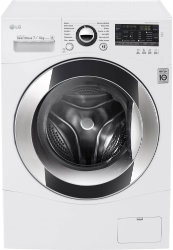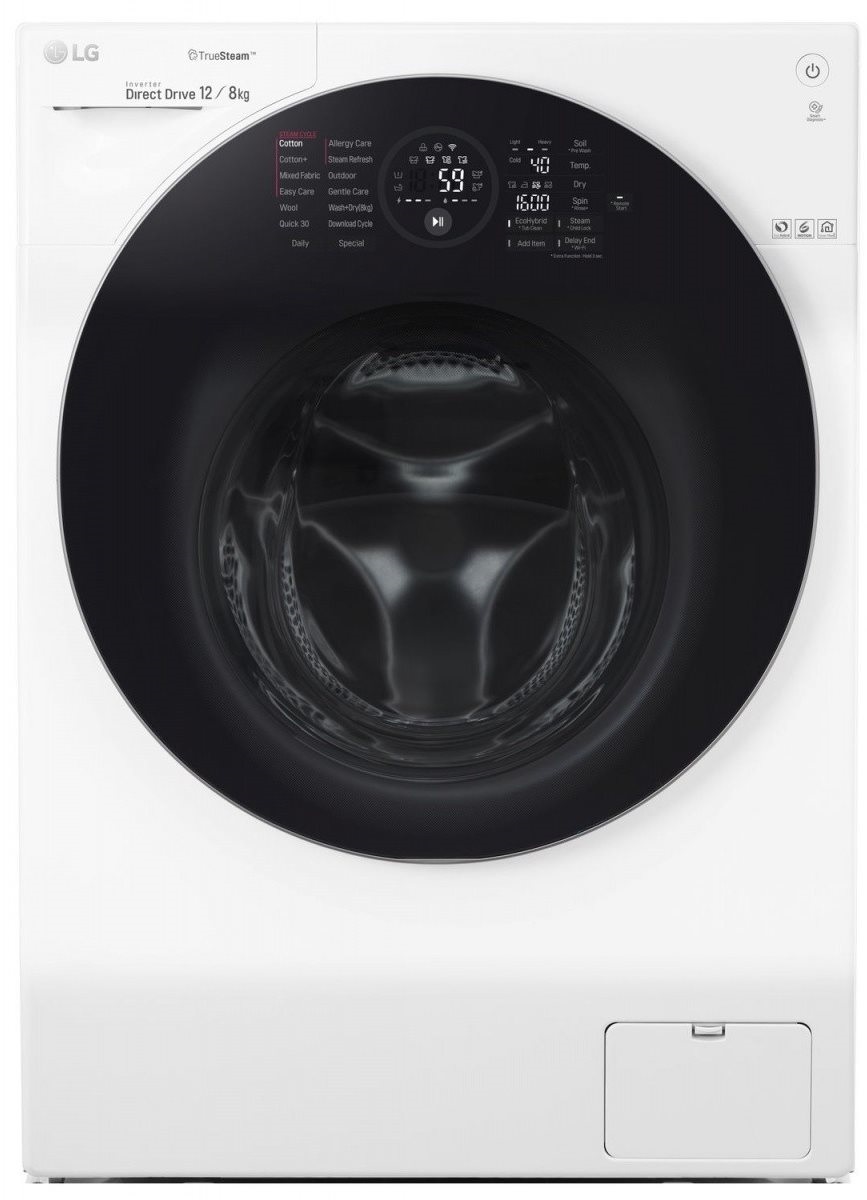How To Choose a Washer Dryer
The combined washer and dryer is an ideal choice for households that do not have enough space for two large appliances (washer and a separate dryer). It washes and dries laundry as efficiently as each appliance would separately, saving you not only space but also money. It contains most of the washing programs as a normal washing machine, only in the case of a dryer function is it necessary to take into account a less varied range of functions than in the case of a stand-alone device.

A few tips for choosing a washer-dryer
The key is knowing the size of the space you are going to put your washing machine, this will dictate the depth and width of the machine you choose
For smaller bathrooms, choose the narrow variant (SLIM) with a depth of up to 50 cm
Don't forget enough to leave enough space to open the door and comfortably load the washing machine
Think about what features are essential to you, not all washing machines have the same
Optional steam programs leave laundry fluffy and fragrant
If you frequently wash jackets, sweaters and other larger pieces of clothing, choose a washer-dryer with a higher speed
Basic parameters for selecting a washer-dryer
Washing machine depth
Washer-dryers have a standard depth of over 50 cm (most often around 60 cm). A smaller variant is the SLIM with a depth of up to 50 cm which is intended for smaller spaces. However, it should be taken into account that smaller models of washing machines have a lower capacity and are therefore most suitable for households with 1 or 2 members.
Washing machine capacity
Washing-dryers usually have a larger washing capacity than they do for drying. So, for example, they wash 9 kg of laundry, but can only dry 6 kg. Therefore, if you load the washing machine so that it’s almost full, you should expect to dry the washed laundry in several stages.
In general, however:
Washing machine motor
The motor affects the noise of the washing machine and the electricity consumed. You can come across three basic types of motor, while the first type is used only minimally and we can consider it rather obsolete.
Compared to newer models, the classic motor is noisier and has higher energy consumption because it is located off the axis of the drum and the transmission of electricity to the motor takes place by means of carbons. However, they wear out over time and need to be changed. It consists of four basic components: engine, belt, pulley and drum.
The inverter motor, like the classic one, consists of a motor, a belt, a pulley and a drum, and its location is also identical. However, it is significantly less noisy and has lower energy consumption than a conventional motor, because it is controlled electronically. Thanks to this, its regulation is direct and smooth. In addition, the principle of electronic speed control reduces vibration, wear and provides higher performance at lower noise levels.
The direct drive motor is the most modern type of motor for the best washing machines. It is located in the axis of the drum, so no belt or pulley is needed anymore. It directly drives the motor and increases its controllability and stability. The vibrations of the washing machine are reduced when using the direct drive motor.
Speed
Higher spin speeds are especially important if you frequently wash jackets, sweaters and other larger pieces of clothing. A washing machine with at least 1200 revolutions per minute can also remove most of the moisture from clothing.
Do you already own or plan to buy a dryer? Then we recommend a washing machine with 1,400 rpm and more to remove residual moisture. The laundry will be dried more efficiently and will be perfectly dry after only one drying cycle.
The speed can be regulated downwards, so you don't have to worry about buying a washing machine with 1,400 rpm and washing delicate laundry in it.
Laundry spun at a low speed contains a lot of excess water. Drying it in the dryer is very energy intensive and takes longer. If you have the opportunity and it does not harm the laundry, spin at high speed and only then dry the laundry in the dryer.
Energy class of washing machines
The energy class indicates the grouping according to the energy intensity of the appliance while in operation. For easier selection, there is an energy label, which must be marked on each washer-dryer. Annual water and energy consumption is based on 220 standard wash cycles per year with a half loaded drum at 60 ° C and 40 ° C.
Washer-dryers are manufactured in the energy class A and (unlike most washing machines) also in class B.
Energy consumption |
Consumption in kWh |
Costs in CZK |
|---|---|---|
| A | 5,44 | 20 |
| B | 6,48 | 24 |
|
* Calculated at the price of CZK 3.71 / kWh * A class A washer dryer consumes up to 5 times more energy than a normal class A washing machine A. |
||
Other additional functions
When choosing a washer-dryer, take into account other useful features:
Types of washers-dryers
Standard washer-dryers with a depth of more than 50 cm are ideal for homes where not every inch of space needs to be saved. They are very popular with customers, so you can choose from a wide range of brands, special functions, drum capacities, design and other features. However, you should remember that even if you wash a larger volume of laundry, in most cases you will only be able to dry part of it and you will need to do a drying more than once. Washer-dryers can wash more laundry than they can dry.
If you have a smaller space for your washing machine and are counting every inch, a narrow washing machine with a dryer up to 50 cm deep will be ideal for you. Its capacity is plenty enough for households with a smaller volume of laundry and also consumes less water and electricity than if you owned a standard washer and dryer.
The high steam temperature can heat the inside of the drum faster than water, which is why steam washers are an energy-saving solution. In addition, steam can reliably remove bacteria and allergens found in laundry. Front-loading steam washers can be purchased in both standard and SLIM sizes.
If you have enough space for two large appliances, get a set of washers and dryers. The price is almost the same as buying a combined washer-dryer and offers more special features. In addition, some models can be stacked, saving space in the bathroom.
Frequently asked questions when choosing a washer-dryer
What capacity of washer-dryer to choose?
For households with 1 or 2 members, a capacity of up to 6 kg will suffice. An ordinary family with 4 members should choose a washing machine with a load capacity of 9 kg and larger households must look for even higher capacity.
Washer-dryers usually have a lower drying capacity than they do for washing clothes. Therefore, if you fill the machine to its max capacity for washing, you will not be able to dry the entire load without taking some out.
Which energy class of washer-dryer is most advantageous?
Energy class expresses energy, water consumption and washing and drying efficiency. Washers combined with a dryer are only produced in energy classes A and B. With a higher energy class, the price of the appliance also increases, so the most economical washer-dryers in class A are suitable for frequent use, as the money you will save on energy and water bills will pay for the machine in a relatively short period of time.
Do the dimensions of the washer-dryer affect its properties?
Apart from the different volumes of laundry that can fit in the washer-dryer, the dimensions of the appliance do not affect its properties. Conventional front-loading washer-dryers have dimensions of 85 × 60 × 60 cm. However, there are also washer-dryers with a smaller depth (from 40 cm) and ones with a width from 44.5 cm. These models are designed for smaller spaces and have a lower load capacity. If space is not an issue, we recommend choosing standard dimensions with a higher capacity. It is an investment in the future.
Is a washer-dryer better than two separate appliances?
The main advantage of a washer-dryer is space saving. It is therefore also suitable for small apartments. A larger capacity, a more varied selection of drying programs and slightly higher efficiency speaks in favor of a stand-alone dryer. For some models, however, the difference may be negligible. So it's up to you to decide which will best suit your needs.
Glossary - washing machines
Fuzzy logic / 6th sense
Fuzzy Logic and 6th sense technologies work on the same principle. They differ only in the name depending on which manufacturer the washing machine comes from. It is a sensor technology that weighs the laundry itself and recognizes how the washing should take place. It then sets the consumption of water, detergent and the length of the wash cycle according to the measured values. Washing machines with this technology wash more efficiently and can save electricity and water.
Inverter motor
The inverter motor is more reliable and durable than a conventional motor using carbons, which wear out over time and cause friction and sparking. The inverter motor works on the principle of electronic speed control, which reduces vibration and wear and provides higher power at lower noise levels. Inverter motor manufacturers usually provide a 10-year warranty.
Steam programs
Steam programs are used to freshen delicate items, to remove creases and to eliminate odors and allergens. Everything is done thanks to a steam generator, which changes water of normal temperature into steam. It naturally loosens the fibers, fluffs them and loosens creases. Therefore, the detergent penetrates deeper and can remove stubborn stains, unpleasant odors and detergent residue. After 20 minutes, the laundry is smoother and softer in the steam washer than when using normal programs.











